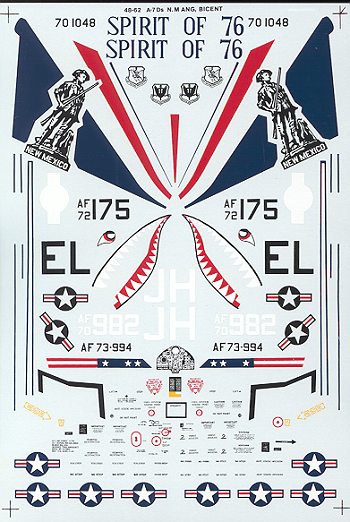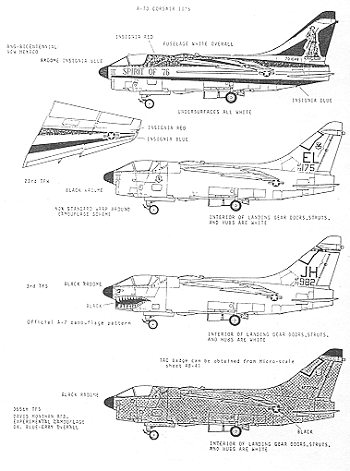 In the mid 1960's it was obvious that a replacement for the A-4
Skyhawk was needed. Back in those days, aircraft had an expected life of
about15, maybe 20 years, unlike today's aircraft that have added another 10-15
years to that figure! Anyway, the winning aircraft for a light attack
plane came from LTV. Their aircraft looked very much like a transonic Crusader
with a high wing, low nose intake and low tailplanes. What made this aircraft
different was that it was designed to carry a respectable offensive load.
In the mid 1960's it was obvious that a replacement for the A-4
Skyhawk was needed. Back in those days, aircraft had an expected life of
about15, maybe 20 years, unlike today's aircraft that have added another 10-15
years to that figure! Anyway, the winning aircraft for a light attack
plane came from LTV. Their aircraft looked very much like a transonic Crusader
with a high wing, low nose intake and low tailplanes. What made this aircraft
different was that it was designed to carry a respectable offensive load.
Three wing pylons for fuel tanks and ordnance were part of the package as was
a set of fuselage-mounted Sidewinder rails for self defense. Included were also
a pair of 20mm cannon, each mounted low in the nose section. This aircraft was
designed to have easy access to all the weapons and avionics systems so that a
quick turn-around rate was possible.
To harken back to an earlier day when there were prop-driven Vought aircraft
on carrier decks, this aircraft was given the title of Corsair, like so many of
those other aircraft. It was quite a success with the Navy, first seeing action
in the late 1960s.
The US Air Force was also in need of a light attack aircraft to replace the
F-100s and A-1s that it had been using up to that point. The A-7 looked to be
what it was seeking. Of course, they couldn't use a straight Navy version! One
of the changes that were made, was to a higher rated and more reliable turbofan
engine (that the Navy would later use on it's A-7E). Also changed was the air refueling
setup from the Navy's probe and drogue system to the USAF boom system. Another
item changed and used in the A-7E was the gun, which was replaced by a single
20mm gatling gun; a gun that had a higher rate of fire than the twin
single-barrel 20mms of the A-7A/B/C. Along with some other mods, this became the
A-7D.
It first saw combat in the early 1970s and some post war crises. It's stay in
the regular Air Force was rather short for a new aircraft and the type soon
began filling the ranks of a large number of ANG units. The A-7D was finally
retired from the USAF in the early 1990s, just a few years after the last USN
Corsair IIs were retired.
 On to the sheet. This one is
a Superscale production and as such, does not have the common decal placement
chart that was with the Microscale release. For some reason, Superscale felt it
could save money by not printing both sides of the instruction sheet on those
sheets it got from Microscale. As a result, there isn't any common marking
placement data. To me, not the best of situations. Anyway, there is enough
common stuff to do one of the four subjects and enough insignia to do three.
Except for the first subject, all of the aircraft are from regular USAF units.
On to the sheet. This one is
a Superscale production and as such, does not have the common decal placement
chart that was with the Microscale release. For some reason, Superscale felt it
could save money by not printing both sides of the instruction sheet on those
sheets it got from Microscale. As a result, there isn't any common marking
placement data. To me, not the best of situations. Anyway, there is enough
common stuff to do one of the four subjects and enough insignia to do three.
Except for the first subject, all of the aircraft are from regular USAF units.
First on the sheet is a very nice Bicentennial A-7D from the 188 TFS New
Mexico ANG. The aircraft is mostly white. You will have to paint all of the
stripes except the tail ones.
Next is one from the 23rd TFW before it started using the sharkmouth design.
This one is in SEA wrap camouflage, a new scheme at the time that soon became
standard.
The third scheme is a nice shark-mouthed A-7D from the 3rd TFS in Thailand
during the last years of the Vietnam War. It is in standard SEA camouflage.
Finally, a rather drab SLUFF in an experimental scheme with the 355th TFS. It
says it is a dark blue grey overall, but I'd be willing to bet it was the grey
that was finally used with the Euro I camouflage scheme. You'll have to scrounge
up the black insignia from another source as all the sheet provides are the
serial numbers and TAC badges.
Naturally, the kit of choice for this sheet is the Hasegawa A-7D. There is
the ESCI kit in this scale, but take it from me, you don't want to put yourself
through the trauma of using that particular kit!!
 In the mid 1960's it was obvious that a replacement for the A-4
Skyhawk was needed. Back in those days, aircraft had an expected life of
about15, maybe 20 years, unlike today's aircraft that have added another 10-15
years to that figure! Anyway, the winning aircraft for a light attack
plane came from LTV. Their aircraft looked very much like a transonic Crusader
with a high wing, low nose intake and low tailplanes. What made this aircraft
different was that it was designed to carry a respectable offensive load.
In the mid 1960's it was obvious that a replacement for the A-4
Skyhawk was needed. Back in those days, aircraft had an expected life of
about15, maybe 20 years, unlike today's aircraft that have added another 10-15
years to that figure! Anyway, the winning aircraft for a light attack
plane came from LTV. Their aircraft looked very much like a transonic Crusader
with a high wing, low nose intake and low tailplanes. What made this aircraft
different was that it was designed to carry a respectable offensive load.  On to the sheet. This one is
a Superscale production and as such, does not have the common decal placement
chart that was with the Microscale release. For some reason, Superscale felt it
could save money by not printing both sides of the instruction sheet on those
sheets it got from Microscale. As a result, there isn't any common marking
placement data. To me, not the best of situations. Anyway, there is enough
common stuff to do one of the four subjects and enough insignia to do three.
Except for the first subject, all of the aircraft are from regular USAF units.
On to the sheet. This one is
a Superscale production and as such, does not have the common decal placement
chart that was with the Microscale release. For some reason, Superscale felt it
could save money by not printing both sides of the instruction sheet on those
sheets it got from Microscale. As a result, there isn't any common marking
placement data. To me, not the best of situations. Anyway, there is enough
common stuff to do one of the four subjects and enough insignia to do three.
Except for the first subject, all of the aircraft are from regular USAF units.